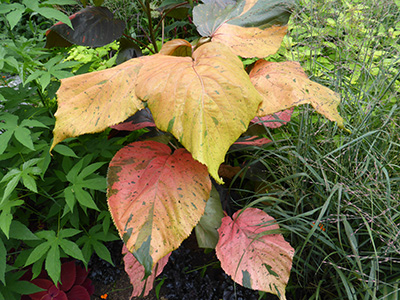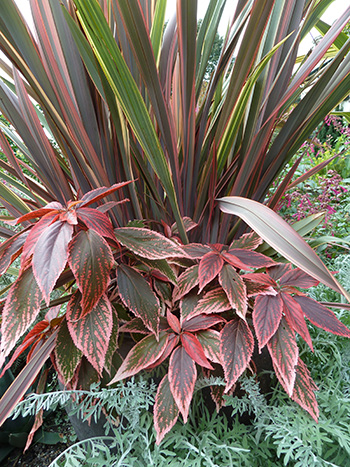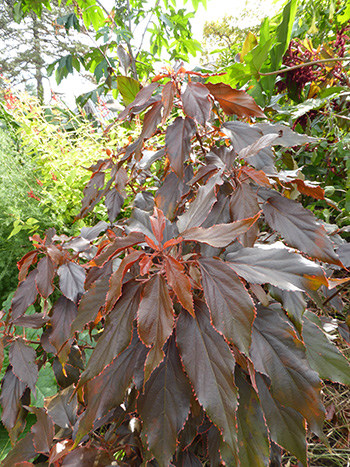Acalypha
 Digging tender plants as threat of frost looms allows for a moment of reflection. With a finite amount of greenhouse space, only so many plants can overwinter within the warm glass walls of the Wister Greenhouses. As such, only plants that have proven their worth are granted sanctuary. One genus always given sanctuary is Acalypha.
Digging tender plants as threat of frost looms allows for a moment of reflection. With a finite amount of greenhouse space, only so many plants can overwinter within the warm glass walls of the Wister Greenhouses. As such, only plants that have proven their worth are granted sanctuary. One genus always given sanctuary is Acalypha.
Chances are you’re familiar with at least one member of the genera. The chenille plant, Acalypha hispida, was a popular hanging basket houseplant grown for its long, drooping, furry red catkin-like flowers. Acalypha is a member of Euphorbiaceae; one of the largest euphorb genera with roughly 550 species! The genus name is derived from the Greek word akalephes, meaning nettle, a reference to the nettle-like leaves. It is the colorful nettle-like leaves that initially attracted me to the genus and its myriad of, in my opinion, underutilized cultivars.

Each leaf of Acalypha miltoniana emerges and develops with its own unique character and coloration. One leaf may be olive green with streaks of orange, another half red and half orange, while another streaked with chartreuse, pink, and copper red. photo credit: J. Coceano
Acalypha miltoniana, aptly named the giant leaf acalypha, produces large 8- to 10- inch ovate leaves on plants reaching four feet in height and width. Each leaf emerges and develops with its own unique character and coloration. One leaf may be olive green with streaks of orange, another half red and half orange, while another streaked with chartreuse, pink, and copper red.
Acalypha wilkesiana ‘Kilauea’ is smaller in stature than A. miltoniana with thin, linear bronze-green leaves edged in orange, red, or some combination thereof. The plant is great in mass at the front of a bed or border and performs equally well in containers so long as provided with ample moisture.
Acalypha wilkesiana Tiki series currently contains eight cultivars, each distinctively different from the others in leaf shape/size and foliage color. ‘Tiki Jungle Cloak’ was offered at the 2014 Unusual Tropicals and Annuals Plant Sale. The cultivar sports a camouflage-like randomized pattern of colors. The large leaves are bronze, copper-orange, chartreuse-green, and pink. ‘Tiki Peach Whirl’ is an upright, larger variety having hand-sized creamy peach and green leaves that twist and twirl. ‘Tiki Tropical Tempest’ has leaves that are lemon-yellow flecked with mint green. While most acalypha tend to grow upwards before filling out, members of the Tiki series are more compact and better branched.
All Acalypha are frost-sensitive tropical and sub-tropical plants. A. wilkesiana, indigenous to Fiji and neighboring South Pacific islands, is an evergreen, often suckering, tropical woody shrub or subshrub that grows 10-15’ tall and as wide in frost-free areas. It is typically grown as an annual in the Greater Philadelphia area where it will grow 2-4’ tall in a single growing season. Acalypha shine in the summer and early autumn garden. Plants take off and produce copious growth once the heat and humidity of July and August kicks in. While a plant for full to partial sun, don’t allow plants to dry out. Consider including in a container where the large, bold, colorful leaves provide continuous impact.
If desired, acalypha can be overwintered indoors. We propagate from cuttings (to save on greenhouse space) and dig and repot mature plants to obtain a greater impact for next seasons plantings. Some degree of leaf drop should be expected and typically doesn’t harm the plant. Be observant for mealy bug, a common indoor pest.
As this season’s garden is put to bed, and thoughts turn toward the next, consider adding acalypha to the mix. You’ll be hard pressed to find a foliage plant with greater impact or diversity of form and color.








No Comments